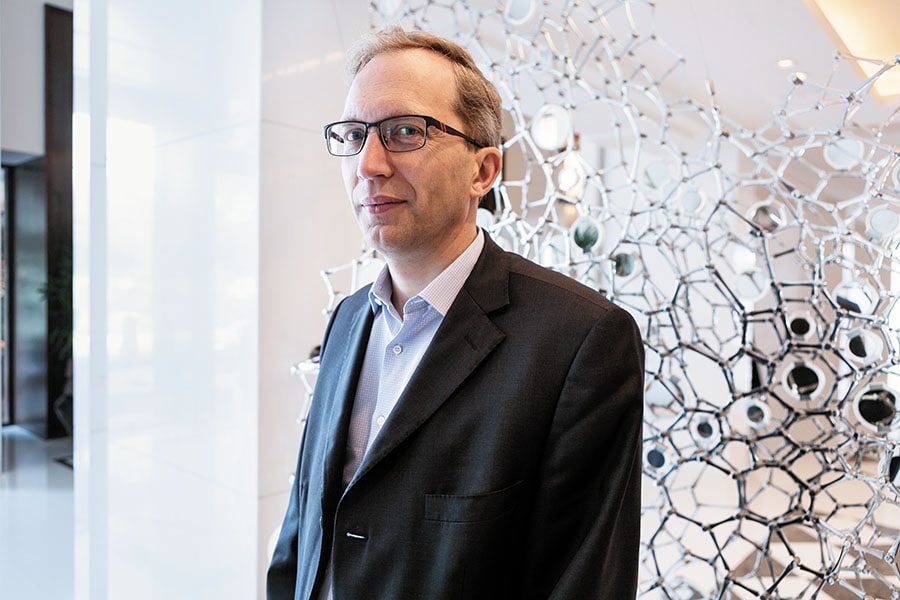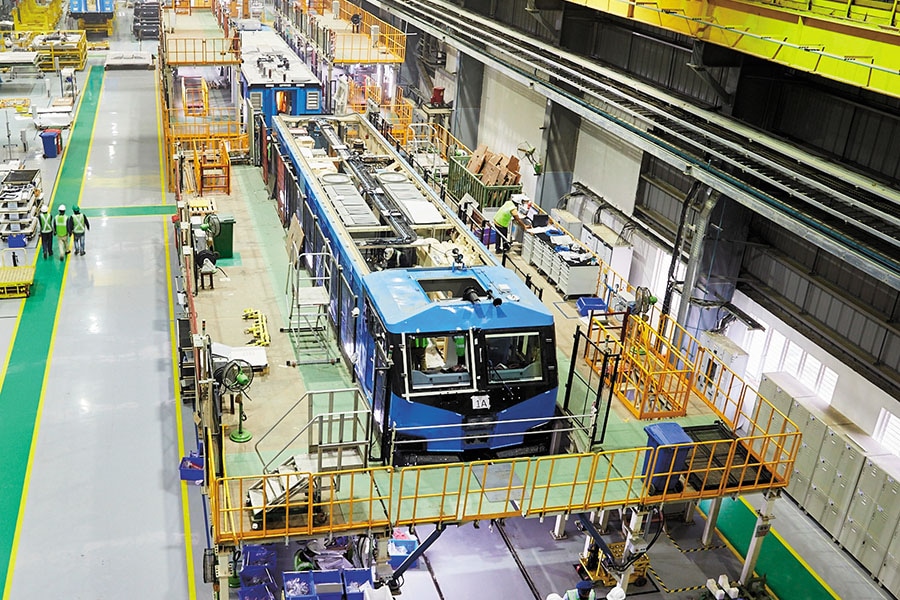
Mobility is at the heart of everybody's challenge: Henri Poupart-Lafarge
Alstom's CEO speaks on why the future of transport is electric and how new technologies will demand fresh solutions
 Image: Madhu Kapparath
Image: Madhu Kapparath
India is a crucial market for Alstom, says Henri Poupart-Lafarge, 48, the CEO of the French multinational and railway major. In March, the company announced the launch of its first electric locomotive from its facility in Madhepura, Bihar. In an interview with Forbes India, Poupart-Lafarge talks about why India is a potential manufacturing hub, the rapid modernisation of the railway infrastructure in the country and how hydrogen trains could be an integral part of transport in the near future. Edited excerpts:
Q. India is a crucial market for you. Do you come here often?
We are now in India with the French delegation [French President Emmanuel Macron was in the country in March], but I have been coming to India for several years as we have had a number of activities lined up; the first time I came was in 2000.
Among our recent projects was the launch of an all-electric locomotive at our facility in Madhepura, Bihar. It has been a fantastic project in partnership with the Indian Railways. In two years, we have managed to develop a new locomotive in India and manufacture our first all-electric one. For us, it is also the first locomotive that is being developed in the Indian market with Indian Railways; this will be the first in the 800 WAG12 twin-section electric locomotives. The production will span over 10 years. We are also aiming to develop new products for the Indian and export markets. Madhepura will be the hub of all our locomotives. Besides, at the factory, we hold test drives and develop equipment to manufacture these locomotives.
Q. Could you tell us about your export plans from India?
We are looking to export in the long term, to the Asian or to the global markets. About five years ago, we developed a factory in Chennai for metro coaches. This was done for the Indian and export markets. For example, we have exported metros from Chennai to Sydney. India is a fantastic market and offers a great platform to reach out to the Indian as well as the export market.
Q. The Indian government is focusing on the domestic market with schemes like Make in India. What is your sense of the Indian market?
It’s a fantastic market, which has two main drivers. The first is the urban market: All the cities need metros and, subsequently, the need to upgrade, renovate and modernise the mainline network, be it passenger or freight mainlines. These are drivers that make the market extremely positive. Second, we have Make in India, which gives us a strong framework. We are totally in line with the policy as we are investing a lot here; all that we are doing in India is manufacturing in the country.
Q. How good is the metro business? A lot of companies are keen to participate in building metros.
It is a booming business for us. We have a lot of projects. Wherever we go, we are there to stay and partner with the cities. (Alstom has recently signed contracts worth €75 million to supply power equipment to the Mumbai Metro Rail Corporation and Jaipur Metro Rail Corporation, apart from train sets to the Chennai Metro Rail Corporation.) We also have some infrastructure jobs. Alstom is not only into hauling stock, we are also into services, systems and infrastructure. So the contracts that we have signed illustrate competence and the wide range of activities that we have.  Alstom has recently signed contracts worth €75 million to supply power equipment for the metro in various Indian cities, including Mumbai
Alstom has recently signed contracts worth €75 million to supply power equipment for the metro in various Indian cities, including Mumbai
Image: Courtesy Alstom
Q. But the Indian Railways is often considered slow and modernisation has been happening at a snail’s pace. Is that a problem?
There is strong willingness to accelerate things. As I said, I have been coming to India for the last 18 years and I think that speed [of work] has improved tremendously. So, now the challenge is to tackle the needs and be ready to fulfil the requirements. The market is there, but we need to be in a position to answer to the market.
Q. With the launch of the electric engine, what do you reckon is the future for diesel engines?
Around the world, and not only in India, the speed with which diesel is increasingly being banned from mobility, whether in cars or trains, is incredible. It has been over 2-3 years that the world has realised the harm that diesel is causing the environment. We are already developing a hydrogen train to bring new solutions and electric buses for mobility. I think it’s a huge challenge. We are also developing electric buses, something that India is considering as an environment-friendly alternative. Electric buses are and will become the norm in the world and we are prepared for that too.
Q. Will you launch electric buses for India too?
It is early days now. Like we do usually, and as we have done for the metro and locomotives, we will manufacture and implement the solutions in India.
Q. As a railway company, how do you look at new technologies such as hyperloop and flying taxies?
I think it illustrates the fact that mobility is now at the heart of everybody’s challenge. So there are plenty of solutions that we can see. Who would have thought a few years ago that solar would be the winner of power transmissions? What we are sure about is that solutions like the hyperloop or flying taxis are not competing against the railway. The railway is here for capacity, the metro is here for capacity and hyperloop won’t challenge that.
But people are looking for other niche markets that can answer specific needs. And solutions will come from there. We want to be present in the railway sector in electrification and that’s where we are welcoming these new initiatives in multimodality. We are investing in digital technology because, at the end of the day, all these new mobilities have to be coordinated with each other and managed. And that’s all part of the smart mobility challenge.
“ The railway isn’t competing against the flying taxis or the hyperloop. It’s here for capacity and the hyperloop won’t challenge that
Q. In that context, can you take us through some of the plans you have for India?
On the engineering front, more than 20 percent of all engineers of Alstom are based in Bengaluru. This is growing at 20-25 percent per year. So it is now the largest engineering centre for Alstom across the world. One plan is definitely to make India our engineering hub.
The second one is on components. We have a factory in Coimbatore, Tamil Nadu, building equipment, including for hydrogen trains in Europe. We intend to upgrade this factory progressively and make it a world factory.
Then we have urban transport. Last year, we doubled our position in terms of capacity and have large expansion plans in cities. Then, we have Madhepura where we are building the electric locomotives. So we will progressively add different products, as well as infrastructure and systems, that we are doing in Alstom in different cities.
Q. What makes India a manufacturing hub with such potential and how will Alstom benefit from that?
I think it’s a combination of factors. It is a large market, which is extremely important; it is also a competitive platform in terms of cost perspective; it is also a big engineering platform. These, together with the supply chain, make it extremely suitable for being a global platform. We will be here for a long time and have set our eyes forever.
We are extremely excited by the perspective and visibility about the mobility challenge in India. We are lucky that our Indian platform will benefit a lot from this challenge. The world has realised over the last year that mobility now, more than power, is the challenge to development. So to be at the heart of the challenge is extremely important.
We see a huge potential for hydrogen trains in India. We also need to electrify; the future of mobility will be electrified. There will be no diesel in the long term. Now, whether this electrification will be through classical categories, autonomous trains or by hydrogen trains will have to be seen. We will have a combination of all these technologies. Therefore, we are bringing in hydrogen trains in Europe and Canada, and definitely they will be a solution in India for the low-density network.
(This story appears in the 30 November, -0001 issue of Forbes India. To visit our Archives, click here.)





